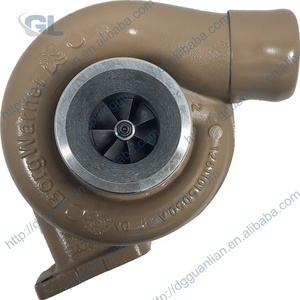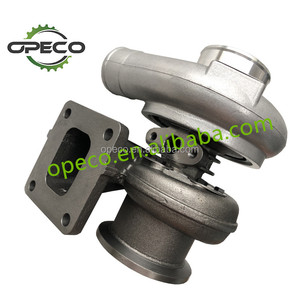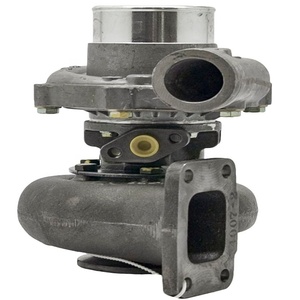(149 products available)


















































































































































































There are two main types of 4045t turbo engines.
Single Turbo:
Single-turbo engines have a single turbocharger attached to the internal combustion engine. The turbocharger uses exhaust gases from the engine to spin a turbine, which then draws in and compresses ambient air into the engine. This increases the engine's power output without significantly raising its weight. The design of single-turbo engines is relatively straightforward, with fewer components, which lowers maintenance requirements and costs. Furthermore, they often operate with a lower lag time, providing a more linear power delivery. However, they may not provide as much boost to high-end power as twin-turbo or turbocharged V8 engines.
Twin Turbo:
Twin-turbo engines have two turbochargers forced onto the internal combustion engine. These turbochargers work to compress the air entering the engine, enhancing its power output. The two turbochargers can be configured in various ways, such as parallel or sequential arrangements. In a parallel arrangement, each turbocharger serves its own chamber of a V-6 or V-8 engine, allowing for quicker spooling and reduced turbo lag. Conversely, a sequential arrangement involves one turbocharger for low-end power and another for high-end power, optimizing the engine's performance across the entire RPM range. This complexity permits twin-turbo engines to generate more power and torque, making them suitable for high-performance vehicles. Nonetheless, the intricate design may increase maintenance requirements and costs.
The specification of the 4045t turbo is as follows:
Engine Size
Displacement of 4.5 liters (4450 cc) is used in the models listed below.
Engine Family
Engines of the following families are used: 6B (6B Cummins), 6BT (6B Cummins Turbo), 6CT (6C Turbo), ISB (ISB Cummins) and QSB (QSB Cummins).
Engine Configuration
Engines with 6 cylinders are used.
Turbocharger
Engines are equipped with turbochargers. The 6BT, ISB, and QSB engines have turbochargers with intercoolers.
Maximum Power
Turbocharged engines have a maximum power output of 150-450 hp. The power output depends on the engine type.
Maximum Torque
Turbocharged engines have a maximum torque of 450-1000 lb-ft. The torque also depends on the engine type.
Operating Speed
The engine's speed varies according to the engine type. The speed ranges from 2300-2900 RPM.
Fuel Type
All the engines listed above are diesel-powered.
Proper maintenance of the 4045t turbo allows for increased reliability and durability. Here are some maintenance tips:
Regular Oil Changes
Changing the oil at regular intervals keeps the turbo lubricated. The lubrication reduces wear and tear, allowing the turbo to function optimally.
Inspecting Oil Lines
Inspecting oil lines for cracks, leaks, or damage is essential. The oil lines are crucial for transporting oil to the turbo. Damage or cracks can disrupt the oil flow, damaging the turbo.
Air Filter Replacement
It is important to replace the air filter regularly. The air filter prevents dirt and debris from entering the turbo. A clogged air filter forces the turbo to work harder, reducing its lifespan.
Cool Down Period
Allowing the engine to cool down before turning off the vehicle is important. The turbo can reach high temperatures from the exhaust gases. Turning off the engine abruptly can damage the turbo.
Regular Inspections
Regular inspections of the 4045t turbo and its components is crucial. Early detection of issues allows for timely repairs, preventing further damage.
Choosing the right 4045t turbo can be a daunting task for many people. Here are some tips that can help make the process easier:
Before purchasing a 4045t turbo, it is important to consider the engine size. The turbocharger chosen should be compatible with the engine size. A larger turbo may provide more power, but it could create lag and not be as efficient. On the other hand, a smaller turbo will spool quickly but may not provide enough power.
Another thing to consider is the driving style. For those who enjoy spirited driving or track days, a 4045t turbocharger that spools quickly and provides instant power is needed. If long-distance cruising is the primary focus, a turbo that focuses on efficiency and low-end torque may be more suitable.
One should also consider the type of fuel when choosing a 4045t turbo. Higher octane fuels can provide more power and efficiency from a turbocharger. It's essential to ensure that the fuel type is compatible with the chosen turbocharger to avoid any damage or performance issues.
Finally, budget plays a significant role in selecting a 4045t turbo. There are many options available at various price points, so it's important to decide on a budget before shopping. Keep in mind that a more expensive turbo may provide better performance and longevity in the long run.
By considering these factors, choosing the right 4045t turbo can be a simple and straightforward process.
Some common signs of a faulty turbo are discussed above. When these signs are noticed, a proper diagnosis should be carried out to confirm that the turbo is actually faulty.
It is advisable to consult a professional mechanic when the turbo needs replacement. This is because the process of replacing a turbo is complex. However, if an experienced mechanic is being used, here are steps they might follow:
Safety first:
The vehicle is parked on a level surface and the engine is turned off. The parking brake is engaged and the warning lights are set up. The vehicle's hood is opened and the hoods are supported.
Disconnect the battery:
The battery is disconnected to prevent electrical accidents.
Drain coolant:
The coolant is drained from the engine to avoid spillages when the turbo is being replaced.
Remove the old turbo:
The exhaust downpipe, intake pipes, oil feed pipes, and oil return pipes connected to the turbo are removed. The turbo is unbolted from the exhaust manifold and the new turbo is placed.
Install the new turbo:
The new turbo is bolted onto the exhaust manifold following the reverse process of removing it. The oil feed pipes and the coolant pipes are reconnected.
Reconnect the battery:
The battery is reconnected after ensuring that all the components are working well and there are no leaks.
Q1: What is the difference between 4045 turbo and other turbochargers?
A1: The difference lies in the specifications and performance. The 4045 turbo is designed for larger engines, typically those found in heavy-duty trucks, construction equipment, and agricultural machinery. It offers improved airflow and exhaust gas handling compared to smaller turbochargers.
Q2: Can the 4045 turbo be used on smaller engines?
A2: Technically, the 4045 turbo can be used on smaller engines. However, it is not recommended. When the turbo is fitted onto smaller engines, it can cause an imbalance in the powerband. This leads to turbo lag and, in most cases, the engine will not run efficiently.
Q3: Are there any 4045 turbo upgrades?
A3: Yes, there are several 4045 turbo upgrades available. The upgrades focus on increasing horsepower and improving throttle response. Upgrades can include new compressor and turbine wheels, high-performance bearings, and custom exhaust housings.
Q4: How can I ensure the 4045 turbo lasts long?
A4: Proper maintenance is the key to ensuring that the 4045 turbo lasts long. Users should ensure proper lubrication and regular oil changes. Additionally, they should check for any boost leaks and keep the air filter clean. It is also important to let the turbo spool down before shutting the engine off.